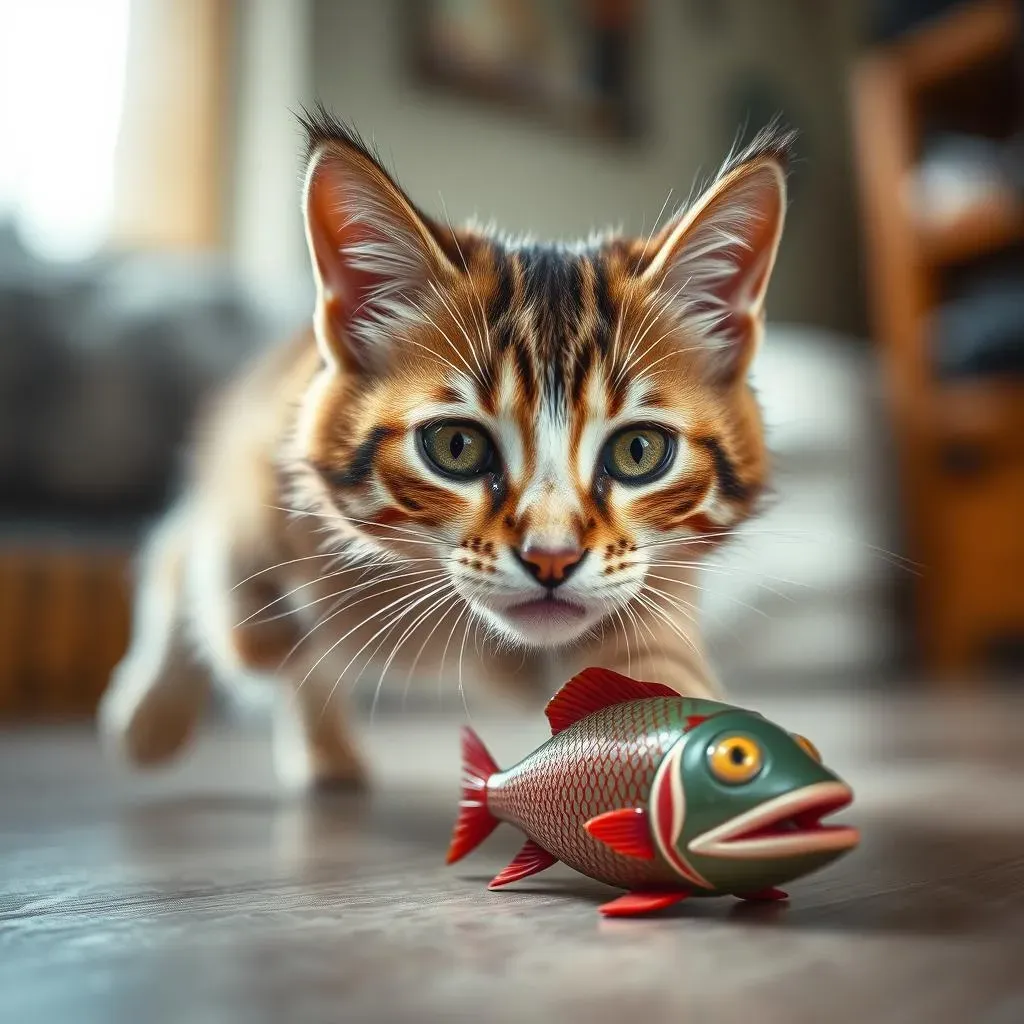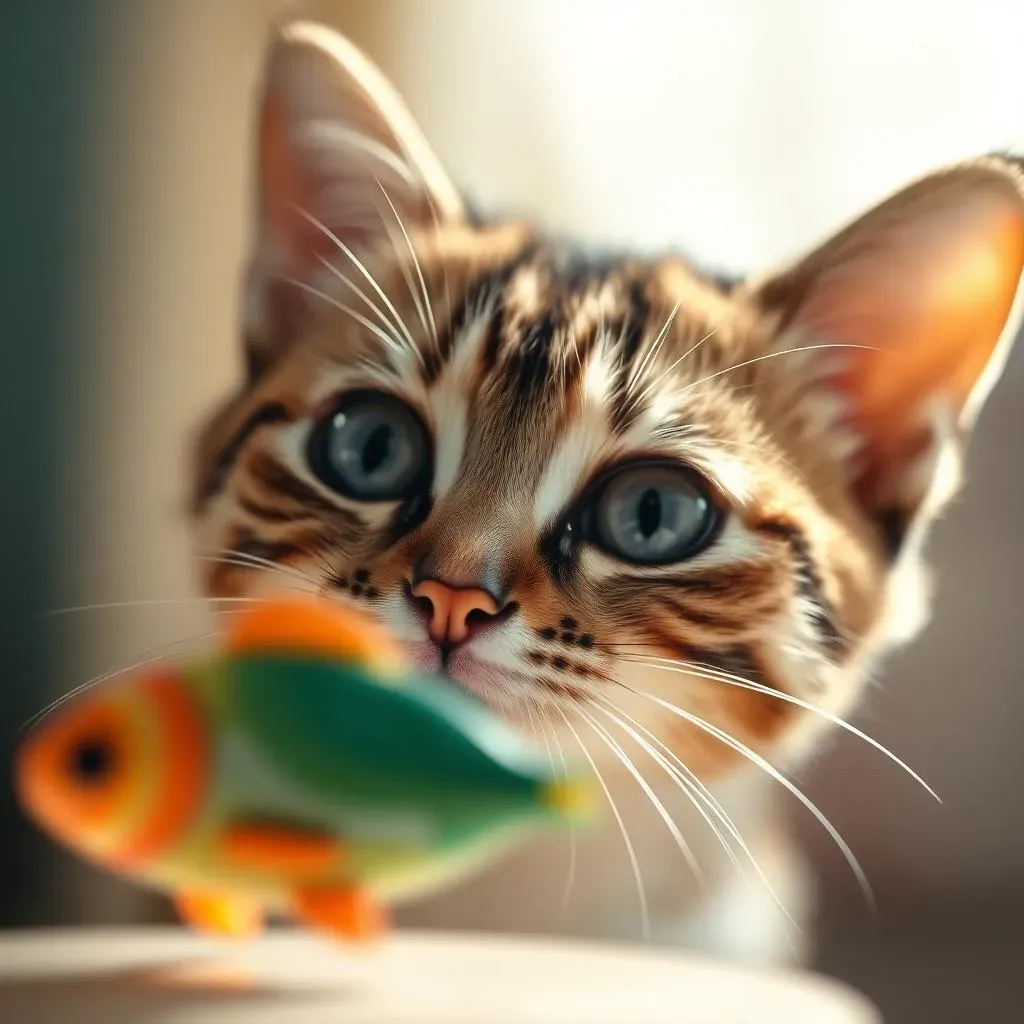Table of Contents
Ever watched your cat stalk an imaginary mouse, their eyes wide with focus? Now, imagine that same intensity directed at a toy that actually moves. That’s the magic of cat toys moving fish! These aren't your grandma's stuffed mice; we're talking about interactive, flopping, wiggling wonders designed to tap into your feline's natural hunting instincts. If you're tired of boring toys that gather dust, or if your cat needs a bit more excitement in their daily routine, this article is for you. We'll explore why cats are so captivated by these moving marvels, how to pick the perfect fishy friend for your pet, and most importantly, how to ensure your cat has a safe and enjoyable playtime. Get ready to make your cat's playtime a splash!
Why Cats Love Moving Fish Toys

Why Cats Love Moving Fish Toys
Okay, so why are cats so obsessed with these flopping fish? It's not just because they're shiny or colorful, though that can help. It's all about tapping into their primal instincts. Cats are born hunters, and that twitching tail or jerky movement of a toy fish triggers their predatory drive. Think of it like this: a real fish in the wild wouldn't just lie still; it would dart and wiggle, trying to escape. A moving fish toy replicates this erratic movement, making it an irresistible challenge for your feline friend. It's a chance for them to practice their hunting skills, even if it's just on a plush toy. It's like a tiny, indoor safari for your cat, minus the actual danger, of course.
Choosing the Right Cat Toys Moving Fish

Choosing the Right Cat Toys Moving Fish
Size and Material Matters
Okay, so you're ready to dive into the world of moving fish toys, but where do you even start? First things first, size matters. A tiny kitten won't be able to wrestle with a huge marlin-sized toy, and a massive Maine Coon might find a small sardine toy underwhelming. Think about your cat's size and how they like to play. Do they prefer to bat at things with their paws, or do they like to grab and wrestle? The material is also a big deal. Look for durable fabrics that can withstand some serious bunny kicks and gnawing. Avoid anything with small parts that your cat could chew off and swallow. Trust me, you don't want a trip to the vet because of a rogue plastic eye.
Power Source and Movement
Next up, let's talk about what makes these toys move. Some toys are battery-powered, and they can give you hours of fun, but you have to replace those batteries. Others are USB rechargeable, which is more eco-friendly, but you need to remember to charge them. The movement itself is also key. Some fish just wiggle their tails, while others flop and twist like a fish out of water. The more erratic the movement, the more likely it is to capture your cat’s attention. Consider your cat's personality when picking the movement type. A lazy cat might prefer a gentle sway, while a more energetic cat will appreciate a wild, thrashing fish. It's all about finding that sweet spot that makes your cat go "Oh, it's on!"
Feature | Considerations | Why it matters |
|---|---|---|
Size | Match to cat's size | Ensures engagement and safety |
Material | Durable, non-toxic | Prevents damage and ingestion |
Power | Battery vs USB | Convenience and cost |
Movement | Type and intensity | Keeps cat's interest |
How to Introduce Moving Fish Toys to Your Cat

How to Introduce Moving Fish Toys to Your Cat
First Impressions Matter
Alright, you've got your awesome moving fish toy, now what? Don't just plop it down in front of your cat and expect instant adoration. Think of it like introducing a new friend – you want to make a good first impression. Start by letting your cat sniff the toy while it's turned off. Let them get used to the smell and feel of it. Once they seem comfortable, turn it on, but don't let it go crazy right away. Start with gentle movements and see how your cat reacts. If they seem scared, turn it off and try again later. It's all about being patient and letting them adjust at their own pace.
Playtime Techniques
Once your cat is comfortable with the toy, it's playtime! Don't just leave the toy on the floor and walk away. Engage with your cat. Use the toy as a lure, moving it slowly and teasingly to encourage them to stalk and pounce. You can also try hiding the toy behind furniture or under a blanket to make the game more exciting. Remember, cats love the thrill of the hunt, so make it challenging! Keep the play sessions short and sweet – around 10-15 minutes is perfect. You want your cat to be engaged, not overwhelmed. And always, always end the session with a big win for your cat. Let them catch the toy and give them lots of praise. It’ll build their confidence and make them want to play again. You're not trying to train them to be a circus act, just trying to have fun.
Technique | Description | Why it works |
|---|---|---|
Sniff Test | Let cat explore the off toy first | Reduces fear and builds curiosity |
Gentle Start | Start with slow, subtle movements | Allows cat to adjust gradually |
Engage in Play | Use toy as a lure, don't just leave it | Taps into hunting instincts |
Short Sessions | Keep play times brief | Prevents overstimulation |
End with a Win | Let cat "catch" toy | Builds confidence and positive association |
Reading Your Cat's Cues
Every cat is different, and some may take to moving fish toys like a duck to water, while others might need a bit more convincing. Pay attention to your cat’s body language. If they're hissing, flattening their ears, or trying to hide, it's a sign that they're not enjoying the toy. Don't force it. Put the toy away and try again another time. On the flip side, if they're purring, rubbing against the toy, and batting at it with enthusiasm, you've got a winner! Remember, the goal is to make playtime fun and engaging for your cat. Be patient, observant, and most of all, enjoy the bonding experience with your furry friend. Sometimes, the best way to figure out what your cat likes is to just watch them and learn from their reactions. It's all about understanding your cat's personality and what makes them tick.
Troubleshooting and Safety Tips for Cat Toys Moving Fish

Troubleshooting and Safety Tips for Cat Toys Moving Fish
Okay, let’s talk about when things don’t go as planned. What if your cat is completely ignoring the fancy new fish? Or worse, what if they’re trying to eat it? First off, don't panic. Not every toy is a hit with every cat. If your cat seems uninterested, try switching up the way you play. Maybe the gentle sway doesn't cut it for them; try a more erratic movement. Or, they might just need a break. Don't force it. The other big worry is safety. Those little plastic eyes or fins can be a choking hazard, so always supervise your cat during playtime. And, if a toy starts to fall apart, it's time to retire it. Better safe than sorry, right? Think of it like a car, you want to make sure everything is running smoothly and safely.
Another common issue is that the toy might stop working. If it's battery-powered, check the batteries. If it's USB rechargeable, make sure it's charged. Sometimes, the internal mechanisms can get jammed, especially if your cat is a rough player. If you can't fix it yourself, it might be time to get a new one. Also, consider the environment. Is your cat distracted by other things? Try playing in a quiet area with fewer distractions. And if the toy is too loud or the movement is too intense, it might be scaring your cat. Try a different toy or a slower setting. Remember, patience is key. Just like finding the perfect pair of jeans, it can take a few tries to find the right toy for your cat.
Problem | Solution | Prevention |
|---|---|---|
Cat ignores toy | Try different movements or play styles | Observe cat's preferences |
Toy becomes a hazard | Supervise playtime, discard damaged toys | Inspect toys regularly for wear |
Toy stops working | Check batteries/charge, try to fix mechanism | Choose quality toys |
Cat is scared | Try a quieter toy or slower movements | Introduce new toys gradually |
Finally, let's talk about cleaning. Moving fish toys can get pretty gross after a while. They're dragged across the floor, slobbered on, and sometimes even used as a scratching post. Most of them can be spot cleaned with a damp cloth and some mild soap. Just make sure they're completely dry before giving them back to your cat. You can also try putting the toy in a mesh laundry bag and washing it on a gentle cycle, but double check the instructions from the manufacturer first. Think of it as giving your cat's favorite toy a little spa day. By keeping the toy clean and in good working order, you'll ensure that your cat can keep enjoying it for a long time to come. It is a win-win situation for you and your cat.